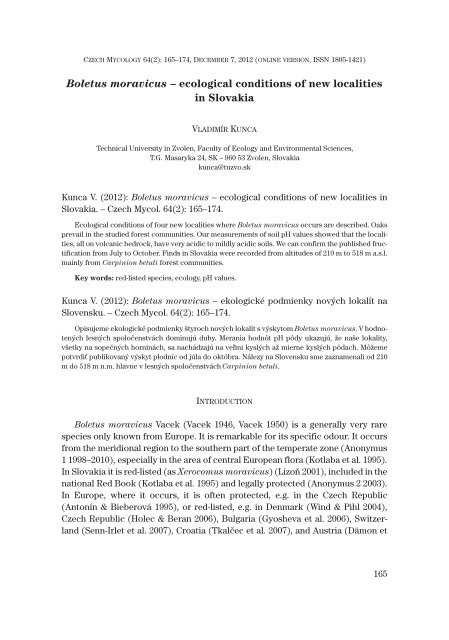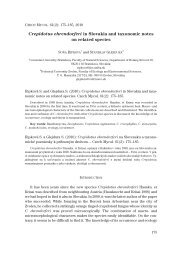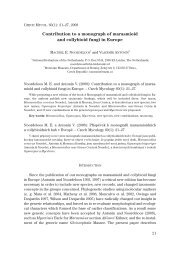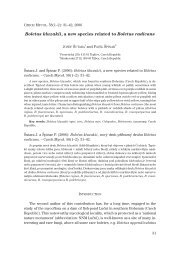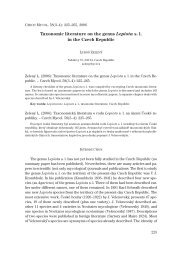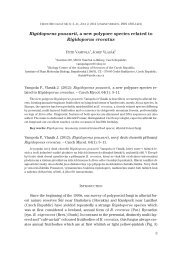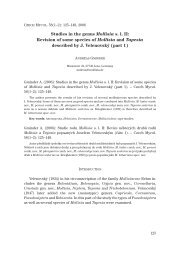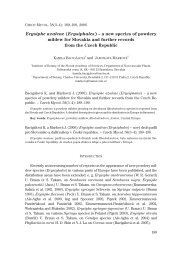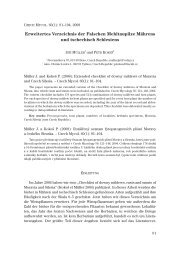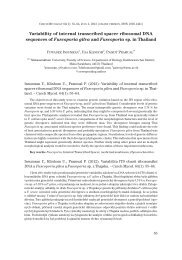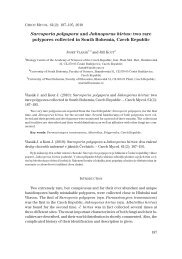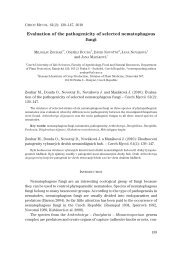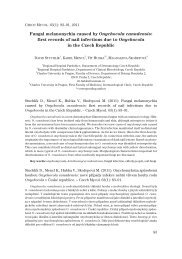Boletus moravicus - CZECH MYCOLOGY
Boletus moravicus - CZECH MYCOLOGY
Boletus moravicus - CZECH MYCOLOGY
Create successful ePaper yourself
Turn your PDF publications into a flip-book with our unique Google optimized e-Paper software.
<strong>CZECH</strong> <strong>MYCOLOGY</strong> 64(2): 165–174, DECEMBER 7, 2012 (ONLINE VERSION, ISSN 1805-1421)<br />
<strong>Boletus</strong> <strong>moravicus</strong> – ecological conditions of new localities<br />
in Slovakia<br />
VLADIMÍR KUNCA<br />
Technical University in Zvolen, Faculty of Ecology and Environmental Sciences,<br />
T.G. Masaryka 24, SK – 960 53 Zvolen, Slovakia<br />
kunca@tuzvo.sk<br />
Kunca V. (2012): <strong>Boletus</strong> <strong>moravicus</strong> – ecological conditions of new localities in<br />
Slovakia. – Czech Mycol. 64(2): 165–174.<br />
Ecological conditions of four new localities where <strong>Boletus</strong> <strong>moravicus</strong> occurs are described. Oaks<br />
prevail in the studied forest communities. Our measurements of soil pH values showed that the localities,<br />
all on volcanic bedrock, have very acidic to mildly acidic soils. We can confirm the published fructification<br />
from July to October. Finds in Slovakia were recorded from altitudes of 210 m to 518 m a.s.l.<br />
mainly from Carpinion betuli forest communities.<br />
Key words: red-listed species, ecology, pH values.<br />
Kunca V. (2012): <strong>Boletus</strong> <strong>moravicus</strong> – ekologické podmienky nových lokalít na<br />
Slovensku. – Czech Mycol. 64(2): 165–174.<br />
Opisujeme ekologické podmienky štyroch nových lokalít s výskytom <strong>Boletus</strong> <strong>moravicus</strong>. V hodnotených<br />
lesných spoločenstvách dominujú duby. Merania hodnôt pH pôdy ukazujú, že naše lokality,<br />
všetky na sopečných horninách, sa nachádzajú na veľmi kyslých až mierne kyslých pôdach. Môžeme<br />
potvrdiť publikovaný výskyt plodníc od júla do októbra. Nálezy na Slovensku sme zaznamenali od 210<br />
m do 518 m n.m. hlavne v lesných spoločenstvách Carpinion betuli.<br />
INTRODUCTION<br />
<strong>Boletus</strong> <strong>moravicus</strong> Vacek (Vacek 1946, Vacek 1950) is a generally very rare<br />
species only known from Europe. It is remarkable for its specific odour. It occurs<br />
from the meridional region to the southern part of the temperate zone (Anonymus<br />
1 1998–2010), especially in the area of central European flora (Kotlaba et al. 1995).<br />
In Slovakia it is red-listed (as Xerocomus <strong>moravicus</strong>) (Lizoň 2001), included in the<br />
national Red Book (Kotlaba et al. 1995) and legally protected (Anonymus 2 2003).<br />
In Europe, where it occurs, it is often protected, e.g. in the Czech Republic<br />
(Antonín & Bieberová 1995), or red-listed, e.g. in Denmark (Wind & Pihl 2004),<br />
Czech Republic (Holec & Beran 2006), Bulgaria (Gyosheva et al. 2006), Switzerland<br />
(Senn-Irlet et al. 2007), Croatia (Tkalčec et al. 2007), and Austria (Dämon et<br />
165
<strong>CZECH</strong> <strong>MYCOLOGY</strong> 64(2): 165–174, DECEMBER 7, 2012 (ONLINE VERSION, ISSN 1805-1421)<br />
al. 2009). B. <strong>moravicus</strong> is included in the candidate species list for the European<br />
red-list (Anonymus 1 1998–2010).<br />
Kotlaba et al. (1995) presents two localities in Slovakia – Kuchyňa, Malé Karpaty<br />
Mts. and Kozárovce, Štiavnické vrchy Mts. Beran & Tondl (1997) mention 14 localities<br />
of B. <strong>moravicus</strong> in the Czech Republic. Currently 13 localities are known to V.<br />
Janda (pers. comm.) in the Czech Republic. Šutara & Janda (2006) mention very often<br />
embankments of ponds as localities of B. <strong>moravicus</strong> in the Czech Republic.<br />
The aim of this paper is to describe new localities of B. <strong>moravicus</strong> with notes<br />
on their ecology and to compare our finds with some data on the incidence in<br />
Slovakia and in the Czech Republic.<br />
MATERIAL AND METHODS<br />
Methods.Phytogeographical units follow the classification by Futák (1984).<br />
General geological conditions were taken from available geological maps issued<br />
by the State Geological Institute of Dionyz Stur (on-line) and visually confirmed at<br />
the site.<br />
Soil samples were taken from sites at 10 to 30 cm from sporocarps of B. <strong>moravicus</strong>.<br />
The samples were taken from mineral soil at a depth of 10 cm. Soil sampling<br />
was carried out from September to November 2011. The soil samples were<br />
analysed in the laboratory of Technical University in Zvolen, Faculty of Ecology<br />
and Environmental Sciences, Department of Applied Ecology. Soil pH values were<br />
determined in water suspension (HANNA HI 9321).<br />
Groups of forest types were taken from relevant forest management plans<br />
(maps of forest types), their terminology following Hančinský (1972). In general,<br />
it precisely characterizes ecological conditions of a site and potential natural vegetation.<br />
Moreover, we have also added names of relevant phytosociological units<br />
using the conversion table by Stanová & Valachovič (2002). The nomenclature of<br />
phytosociological units (alliance or association) of the Zürich-Montpellier school<br />
follows Jarolímek & Šibík (2008). Position of the localities is presented in the form<br />
of quadrants (Q) of the Central European grid mapping system (UTM).<br />
Localities and habitat conditions. Data in Tab. 1 present phytogeographical<br />
unit, bedrock, exposition, slope inclination, position on the slope, altitude<br />
and forest characteristics of five localities in Slovakia. In the Štiavnické<br />
vrchy hills (SV) two localities of B. <strong>moravicus</strong> are known from the southern part<br />
of the area, near the villages of Hotianske Nemce (SV1) and Ladzany (SV2). Plot<br />
SV2 was already known (e.g. Škubla 2003), but published data on its ecology were<br />
missing. The locality was found by the author independently from published data.<br />
The locality in the Zvolenská kotlina basin (ZK) is situated between Zvolen and<br />
Banská Bystrica – near the village of Sebedín-Bečov. Localities in the Kremnické<br />
166
KUNCA V.: BOLETUS MORAVICUS – ECOLOGICAL CONDITIONS OF NEW LOCALITIES IN SLOVAKIA<br />
vrchy hills (KV) are located in the SE part of the hills, near Zvolen – KV1 near Turová, KV2 near Budča.<br />
Tab. 1. Habitat conditions of localities with <strong>Boletus</strong> <strong>moravicus</strong>.<br />
locality phytogeographical<br />
unit<br />
bedrock exposition slope<br />
inclination<br />
position<br />
on the slope<br />
altitude (m) forest characteristics<br />
Štiavnické<br />
vrchy hills 1<br />
Slovenské<br />
stredohorie<br />
subunit:<br />
Štiavnické vrchy<br />
lava streams of<br />
andesite<br />
S–SW 5-15° bottom and central<br />
part of the longer<br />
slope<br />
360 middle-aged xerophilous mixed<br />
forest with dominance of Quercus<br />
cerris and Quercus petraea with<br />
Carpinus betulus<br />
Štiavnické<br />
vrchy hills 2<br />
Slovenské<br />
stredohorie<br />
subunit:<br />
Štiavnické vrchy<br />
lava streams of<br />
andesite<br />
S 5° plain base of slope 410 middle-aged xerophilous Quercus<br />
cerris forest with Carpinus betulus<br />
Zvolenská<br />
kotlina<br />
basin<br />
Slovenské<br />
stredohorie, subunit:<br />
Poľana<br />
epiclastic volcanic<br />
breccias to<br />
conglomerates of<br />
andesites<br />
S 25° upper part of the<br />
steep slope<br />
440 older xerophilous Quercus cerris<br />
forest<br />
Kremnické<br />
vrchy hills 1<br />
Slovenské<br />
stredohorie, subunit:<br />
Kremnické vrchy<br />
epiclastic volcanic<br />
conglomerates of<br />
andesites<br />
S–SE 3° wider part of the flat<br />
ridge<br />
485 old xerophilous mixed forest with<br />
dominance of Quercus petraea and<br />
Quercus cerris, Carpinus betulus<br />
and Fagus sylvatica<br />
Kremnické<br />
vrchy hills 2<br />
Slovenské<br />
stredohorie, subunit:<br />
Kremnické vrchy<br />
epiclastic volcanic<br />
breccias of andesites<br />
– 0° large plain area 520 old mesophilous Quercus robur and<br />
Quercus petraea forest with<br />
Carpinus betulus<br />
167
<strong>CZECH</strong> <strong>MYCOLOGY</strong> 64(2): 165–174, DECEMBER 7, 2012 (ONLINE VERSION, ISSN 1805-1421)<br />
S p e c i m e n s a n d c o l l e c t i o n s. Herbarium collections and records from<br />
Slovakia are listed in chronological order. Abbreviation of the herbarium (BRA) is<br />
cited in accordance with the Index Herbariorum (Holmgren et al. 1990). Voucher<br />
specimens from field collections have been deposited in the author’s private herbarium<br />
(PVKU), the BRA herbarium and the personal herbarium of Stanislav<br />
Glejdura, Slovakia, Zvolen (PSG).<br />
Recent collections (published here)<br />
Štiavnické vrchy hills (SV): Q7679d: SV1, Hontianske Nemce, 29 July 2008, herb. PVKU, BRA<br />
CR17829 (Fig. 1), ibid., 12 Aug. 2010, herb. PVKU, BRA CR17830; Q7779a: SV2, Ladzany, 7 Aug. 2008, leg.<br />
& det. V. Kunca, herb. PSG 4666 – Zvolenská kotlina basin (ZK): Q7381d: Sebedín-Bečov, 22 July 2009,<br />
herb. PVKU, BRA CR 17828, ibid., 6 Aug. 2010, herb. PVKU, BRA CR 17827, ibid., 8 Aug. 2011, herb.<br />
PVKU, BRA CR 17826, ibid., 12 Aug. 2011 (Fig. 2), herb. PVKU, BRA CR 17825. – Kremnické vrchy hills<br />
(KV): Q7480a: KV1, Turová, 19 Sept. 2009, herb. PVKU, BRA CR 17831; Q7480a: KV2, Budča, 22 Sept.<br />
2009, herb. PVKU, BRA CR 17832, ibid., 18 July 2010, herb. PVKU, BRA CR 17833.<br />
Herbarium collections<br />
Malé Karpaty hills: Q7569c: Kuchyňa, Vývrať, 23 Aug. 1977, leg. V. Volf, det. P. Lizoň, rev. J. Herink<br />
(1989) (BRA CR8164) – Zvolenská kotlina basin: Q7380d: Sliač, Tilia sp., 30 Aug. 1980, leg. M. Záparka,<br />
det. A. Dermek (BRA CR8162) – Malé Karpaty hills: Q7868a: Bratislava, garden, Picea pungens, 2 Oct.<br />
1984, leg. I. Mišík, det. A. Dermek (BRA CR16858, as Xerocomus leonis) – Štiavnické vrchy hills:<br />
Q7679d: 15 Sept. 1998, leg., det. & herb. J. Šutara (locality identical with SV2) – Štiavnické vrchy hills:<br />
Q7679d: 5 Sept. 2002, 14 Sept. 2006, 12 Aug. 2010, 15 Aug. 2011 leg., det. & herb. P. Špinar (locality identical<br />
with SV2) – Trnavská pahorkatina upland: Q7769b: Viničné, Šenkvický háj, alt. 210 m, broadleaved<br />
forest of Quercus cerris, Acer campestre, 19 Sept. 2010, leg. J. Kuriplach, det. I. Kautmanová,<br />
J. Červenka (BRA CR16628).<br />
Records not documented by voucher specimens<br />
Krupinská planina plateau: Q7780d: 1 km SSE of Čabradský Vrbovok, Frčkov Laz, oak to oak-hornbeam<br />
forest, 29 Aug. 1994 (Škubla 1994, as <strong>Boletus</strong> leonis) – Pohronská pahorkatina upland: Q 7676d:<br />
Kozárovce (Kotlaba et al. 1995) – Štiavnické vrchy hills: Q7679d: Hontianske Nemce, 8 July 2008, leg. &<br />
det. M. Mikšík; 22 Sept. 2009, leg. V. Beňadik, det. V. Kunca (locality identical with SV1).<br />
RESULTS AND DISCUSSION<br />
Geological bedrock and soils<br />
Soil pH values from the studied localities are listed in Tab. 2 and range from 3.9<br />
to 6.27. According to Šály (1996) these values are typical of very acidic to mildly<br />
acidic soils. Pilát & Dermek (1974) mention soils with rich admixture of lime as<br />
typical for B. <strong>moravicus</strong>, whereas Antonín & Bieberová (1995) connect its occurrence<br />
with soils on calcareous bedrock. These data do not correspond with all our<br />
geological characteristics and measurements of pH values.<br />
All our localities occur on volcanic bedrock, which are made of (or are very<br />
close to) andesite. The same can be assumed for some of the localities listed<br />
above – Čabradský Vrbovok on the Krupinská planina plateau and Kozárovce in<br />
the Pohronská pahorkatina upland. These localities, and localities SV1 and SV2<br />
168
KUNCA V.: BOLETUS MORAVICUS – ECOLOGICAL CONDITIONS OF NEW LOCALITIES IN SLOVAKIA<br />
Fig. 1. <strong>Boletus</strong> <strong>moravicus</strong> at locality SV1 (29 July 2008; photo V. Kunca).<br />
Fig. 2. <strong>Boletus</strong> <strong>moravicus</strong> at locality ZK (12 August 2011; photo V. Kunca).<br />
169
<strong>CZECH</strong> <strong>MYCOLOGY</strong> 64(2): 165–174, DECEMBER 7, 2012 (ONLINE VERSION, ISSN 1805-1421)<br />
Fig. 3. Incidence of <strong>Boletus</strong> <strong>moravicus</strong> in Slovakia.<br />
170
KUNCA V.: BOLETUS MORAVICUS – ECOLOGICAL CONDITIONS OF NEW LOCALITIES IN SLOVAKIA<br />
from the southern part of the Štiavnické vrchy hills, are in general influenced by<br />
nutrient rich eolian sediments (loess). This can explain higher pH values for the<br />
first two localities in comparison with the others.<br />
Tab. 2. Soil pH of investigated localities with incidence of B. <strong>moravicus</strong>.<br />
locality SV1 SV2 ZK KV1 KV2<br />
pH value 6.27/5.99* 5.83 5.15 3.9 4.52<br />
* values from 2 microlocalities<br />
Fungal communities<br />
Fungal species found together with B. <strong>moravicus</strong> at the localities can characterise<br />
the studied communities better. At SV1 these are <strong>Boletus</strong> dupainii, B. fuscoroseus,<br />
B. regius, B. rhodoxanthus, B. fechtneri and Amanita caesarea, at SV2<br />
<strong>Boletus</strong> dupainii, B. fuscoroseus and B. regius, atZK<strong>Boletus</strong> regius, B. queletii<br />
and Amanita caesarea, at KV1 <strong>Boletus</strong> fuscoroseus and B. appendiculatus and at<br />
KV2 <strong>Boletus</strong> regius, B. fuscoroseus, B. legaliae, B. impolitus and Polyporus<br />
umbellatus. Pilát & Dermek (1974) describe similar localities with occurrence of<br />
thermophilous boletes. Kluzák & Pravda (1985) reported <strong>Boletus</strong> albidus, B. impolitus,<br />
B. rhodoxanthus and B. appendiculatus from several localities with occurrence<br />
of B. <strong>moravicus</strong>. According to Fellner (1984), all these communities can be<br />
classified as the Boleto (aerei)-Russuletum luteotactae mycocoenosis where<br />
Xerocomus <strong>moravicus</strong> is listed as a characteristic species.<br />
Fructification<br />
Fruitbody production of B. <strong>moravicus</strong> takes place from July to October (22<br />
July – 2 Oct.). Šutara et al. (2009) mention its fructification period from August to<br />
October. Our field experience shows that sporocarps occur in low numbers and<br />
regularly grow at the same microlocalities. The highest number found was 10<br />
sporocarps during one trip (collection). The largest one-day collection from one<br />
locality comprises 12 sporocarps (P. Špinar, pers. comm.) Based on 17 years of observation<br />
in the Luční locality, Czech Republic, Špinar (1998) mentions B. <strong>moravicus</strong><br />
sporocarp occurrence during four months (July–October), the highest number<br />
being found in September. Data from all our collections and records presented<br />
above show that August is the most suitable month for sporocarp production<br />
(Tab. 3).<br />
171
<strong>CZECH</strong> <strong>MYCOLOGY</strong> 64(2): 165–174, DECEMBER 7, 2012 (ONLINE VERSION, ISSN 1805-1421)<br />
Tab. 3. Number of B. <strong>moravicus</strong> collections (based on all available data from Slovakia) found during<br />
four sporocarp production months.<br />
July August September October<br />
number of sporocarps 2 10 6 1<br />
Localities and habitats<br />
Pilát & Dermek (1974) did not cite any locality of B. <strong>moravicus</strong> from Slovakia.<br />
Based on data published here, there are two regions in Slovakia where B. <strong>moravicus</strong><br />
grows (Fig. 3) – thermophilous deciduous forest in SW and Central Slovakia.<br />
Dominant tree species in these forests are oaks (Quercus spp.). Based on published<br />
data, many collections are from the vicinity of oak or from forests with<br />
dominance of oak (Kluzák & Pravda 1985). The same conditions are reported by<br />
Šutara & Janda (2006) and Šutara et al. (2009). Beran & Tondl (1997) mention four<br />
species of Quercus in xerophilous and subxerophilous forests as typical<br />
mycorrhizal partners of B. <strong>moravicus</strong>. The following tree species were found to<br />
be associated with B. <strong>moravicus</strong> at our localities: Quercus cerris, Quercus<br />
petraea, Quercus robur, Carpinus betulus, and Fagus sylvatica.<br />
Based on our phytosociological relevés (Tab. 4), we can assign the occurrence<br />
of B. <strong>moravicus</strong> to the second (Fageto-Quercetum) or third altitudinal forest zone<br />
and to the mesotrophic series (Hančinský 1972). The only find classified in the third<br />
vegetation zone (KV1: Querceto-Fagetum) is probably marginal or in a position<br />
transitional between the second and third vegetation zone, among others due to the<br />
specific local conditions of the microlocality (south-facing flat part of the ridge).<br />
The altitudinal range of the Slovak localities is from 210 m to 518 m. The highest<br />
locality in the Czech Republic is at 437 m above sea level (Pilát & Dermek<br />
1974: Ždánický les). Janda (pers. comm.) calls uplands the typical landscape for<br />
B. <strong>moravicus</strong> in the Czech Republic, where the lowest known locality is at ca. 200 m.<br />
Tab. 4. Vegetation of investigated localities with incidence of <strong>Boletus</strong> <strong>moravicus</strong>.<br />
Locality<br />
Forest type group according to Zlatník’s<br />
typological school (Hančinský 1972)<br />
Syntaxonomical unit according to the<br />
Zürich-Montpellier school<br />
SV1 Fageto-Quercetum Carpinion betuli Issler 1931<br />
SV2 Fageto-Quercetum Carpinion betuli Issler 1931<br />
ZK Fageto-Quercetum Carpinion betuli Issler 1931<br />
KV1 Querceto-Fagetum Carici pilosae-Fagetum Oberd. 1957<br />
KV2 Fageto-Quercetum Carici pilosae-Carpinetum Neuhäusl et<br />
Neuhäuslová ex Neuhäuslová-Novotná 1964<br />
172
KUNCA V.: BOLETUS MORAVICUS – ECOLOGICAL CONDITIONS OF NEW LOCALITIES IN SLOVAKIA<br />
The data on occurrence of B. <strong>moravicus</strong> in Slovakia are probably underestimated.<br />
In some cases it is probably misidentified as Xerocomus subtomentosus.<br />
Our experience show that it is collected together with other Xerocomus species<br />
for consummation, especially in time of massive growth of sporocarps of boletoid<br />
fungi.<br />
Taxonomic note<br />
Specific odour is very typical for almost all sporocarps of B. <strong>moravicus</strong>.Inmy<br />
opinion it is a combination of dill and coco scent. However, Vacek (1946) did not<br />
mention any one in his original description of B. <strong>moravicus</strong>. Beran & Tondl (1997)<br />
describe very intense odour of cinnamon and Šutara (pers. comm.) characterises<br />
the odour as a mixture of dill, coco and vanilla.<br />
ACKNOWLEDGEMENT<br />
The paper was supported by the Slovak Grant Agency VEGA, grants nos.<br />
1/0257/11 and 1/1190/12. We wish to thank Nataša Kandová for laboratory analyses,<br />
Stanislav Glejdura for invaluable advice, Jan Holec, Václav Janda, Pavel Špinar,<br />
Vladimír Antonín and Miroslav Beran for providing scans of papers and valuable information,<br />
and Ján Červenka and Ivona Kautmanová for help with specimens in the<br />
Slovak National Museum, Bratislava. We also thank Ondrej Ťavoda (Institute of Botany<br />
SAS, Bratislava) for technical assistance with the map and Karol Ujházy and<br />
Mariana Ujházyová for help with phytosociological characteristics.<br />
REFERENCES<br />
ANONYMUS 1 (1998–2010): European council for the conservation of fungi 1998–2010: [online database].<br />
– http://www.wsl.ch/eccf/candlist-subtotals.xls. [accessed 24 January 2012].<br />
ANONYMUS 2 (2003): Vyhláška Ministerstva životného prostredia Slovenskej republiky z 9. januára 2003,<br />
ktorou sa vykonáva zákon č. 543/2002 Z. z. o ochrane prírody a krajiny [Regulation of the Ministry<br />
of Environment of the Slovak Republic of January 9 th , 2003 to execute Act No. 543/2002 on nature<br />
and landscape protection]. [in Slovak] – http://www.zbierka.sk/sk/predpisy/24-2003-z-z.p-6956.pdf<br />
[accessed 26 January 2012].<br />
ANTONÍN V., BIEBEROVÁ Z. (1995): Chráněné houby ČR [Protected fungi of the Czech Republic]. – 88 p.<br />
Praha. [in Czech]<br />
DÄMON W., HAUSKNECHT A., KRISAI-GREILHUBER I., eds. (2009): Database of fungi in Austria. –<br />
http://www.austria.mykodata.net. [accessed 8 January 2012]<br />
BERAN M., TONDL F. (1997): Chráněné houby v jižních Čechách [Protected fungi in southern Bohemia].<br />
– 32 p. České Budějovice. [in Czech]<br />
FELLNER R. (1984): Současný stav mykofloristického a mykocenologického výzkumu teplomilných<br />
doubrav střední Evropy [Current state of mycofloristic and mycosociological studies in<br />
173
<strong>CZECH</strong> <strong>MYCOLOGY</strong> 64(2): 165–174, DECEMBER 7, 2012 (ONLINE VERSION, ISSN 1805-1421)<br />
thermophilous oak forests in Central Europe]. – In: Kuthan J., ed., Houby teplomilných doubrav<br />
Československa, p. 3–9, Prague. [in Czech with English summary]<br />
FUTÁK J. (1984): Fytogeografické členenie Slovenska [Phytogeographical classification of Slovakia]. –<br />
In: Bertová L., ed., Flóra Slovenska IV/1, p. 418–419, Bratislava. [in Slovak]<br />
GYOSHEVA M.M., DENCHEV C.M., DIMITROVA E.G., ASSYOV B., PETROVA R.D., STOICHEV G.T. (2006): Red<br />
List of fungi in Bulgaria. – Mycol. Balcanica 3: 81–87.<br />
HANČINSKÝ L. (1972): Lesné typy Slovenska [Forest types of Slovakia]. – 307 p. Bratislava. [in Slovak<br />
with English summary]<br />
HOLEC J., BERAN M., eds. (2006): Červený seznam hub (makromycetů) České republiky [Red list of fungi<br />
(macromycetes) of the Czech Republic]. – Příroda 24: 1–282. [in Czech with English summary]<br />
HOLMGREN P.K., HOLMGREN N.H., BARNETT L.C., eds. (1990): Index Herbariorum 1: The herbaria of the<br />
world. – 704 p. Bronx.<br />
JAROLÍMEK I., ŠIBÍK J., eds. (2008): Diagnostic, constant and dominant species of the higher vegetation<br />
units of Slovakia. – 332 p. Bratislava.<br />
KLUZÁK Z., PRAVDA V. (1985): Hřib moravský – <strong>Boletus</strong> <strong>moravicus</strong> Vacek v Čechách [Tawny Bolete –<br />
<strong>Boletus</strong> <strong>moravicus</strong> Vacek in Czech]. – Sborník Jihočeského muzea 25: 9–11. [in Czech with German<br />
summary]<br />
KOTLABA F. et al. (1995): Červená kniha ohrozených a vzácnych druhov rastlín a živočíchov SR a ČR,<br />
diel 4 Sinice a riasy, huby, lišajníky, machorasty [Red Data Book of Endangered and Rare Plant and<br />
Animal Species of the Slovak Republic and the Czech Republic, vol. 4 Cyanobacteria and Algae,<br />
Fungi, Lichens, Mosses]. – 223 p. Bratislava. [in Slovak with English summary]<br />
KURIPLACH J. (2010): Suchohríb moravský <strong>Boletus</strong> <strong>moravicus</strong> Vacek (1946).<br />
– http://www.nahuby.sk/obrazok_detail.php?obrazok_id=234228. [accessed 24 January 2012]<br />
LIZOŇ P. (2001): Červený zoznam húb Slovenska. 3. verzia (december 2001) [Red list of Slovak fungi. 3 rd<br />
version (December 2001)]. – In: Baláž D., Marhold K., Urban P., eds., Červený zoznam rastlín<br />
a živočíchov Slovenska, Ochrana prírody 20, Suppl., p. 6–13. [in Slovak with English summary]<br />
PILÁT A., DERMEK A. (1974): Hríbovité huby [Boletoid fungi]. – 206 p. Bratislava. [in Slovak with Russian,<br />
English and German summary]<br />
SENN-IRLET B., BIERI G., EGLI S. (2007): Rote Liste. Grosspilze. Rote Liste der gefährdeten Arten der<br />
Schweiz. Ausgabe 2007. – 92 p. Bern. [in German with English, French and Italian summary]<br />
STANOVÁ V., VALACHOVIČ M., eds. (2002): Katalóg biotopov Slovenska [Catalogue of biotopes of<br />
Slovakia]. – 225 p. Bratislava. [in Slovak]<br />
ŠÁLY R. (1996): Pedológia [Pedology]. – 177 p. Zvolen. [in Slovak]<br />
ŠKUBLA P. (1994): Vzácnejšie teplomilné hríbovité huby južného Slovenska [Rare thermophilous<br />
boletes of southern Slovakia]. – Spravodajca Slovenskych Mykológov 2(5): 16–17. [in Slovak]<br />
ŠPINAR P. (1998): Hřib moravský Xerocomus <strong>moravicus</strong> (Vacek) Herink v jižních Čechách [Tawny<br />
Bolete Xerocomus <strong>moravicus</strong> (Vacek) Herink in Southern Bohemia]. – Spravodajca Slovenskych<br />
Mykológov 6(19): 13–14. [in Slovak]<br />
ŠUTARA J., JANDA V. (2006): Xerocomus <strong>moravicus</strong> (Vacek) Herink – In: Holec J., Beran M., eds.,<br />
Červený seznam hub (makromycetů) České republiky [Red list of fungi (macromycetes) of the<br />
Czech Republic], p. 226, Praha. [in Czech with English summary]<br />
ŠUTARA J., MIKŠÍK M., JANDA V. (2009): Hřibovité houby. Čeleď Boletaceae a rody Gyrodon, Gyroporus,<br />
Boletinus a Suillus [Boletoid fungi. Family Boletaceae and genera Gyrodon, Gyroporus, Boletinus<br />
and Suillus]. – 296 p. Praha. [in Czech]<br />
TKALČEC Z., MEŠIĆ A., MATOČEC N. (2007): Crveni popis gljiv a Hr. – http://www.dzzp.hr/dokumenti_upload/20100414/dzzp201004141250262.pdf.<br />
[accessed 7 January 2012]<br />
VACEK V. (1946): <strong>Boletus</strong> <strong>moravicus</strong>, species nova čechoslovaca. – Stud. Bot. Čechosl. 7(1): 36–37.<br />
VACEK V. (1950): Hřib moravský – <strong>Boletus</strong> <strong>moravicus</strong> Vacek. – Česká Mykol. 4(3–5): 45–47.<br />
WIND P., PIHL S., eds. (2004): The Danish Red List. – The National Environmental Research Institute,<br />
Aarhus University, http://redlist.dmu.dk (updated April 2010). [accessed 7 January 2012]<br />
174


